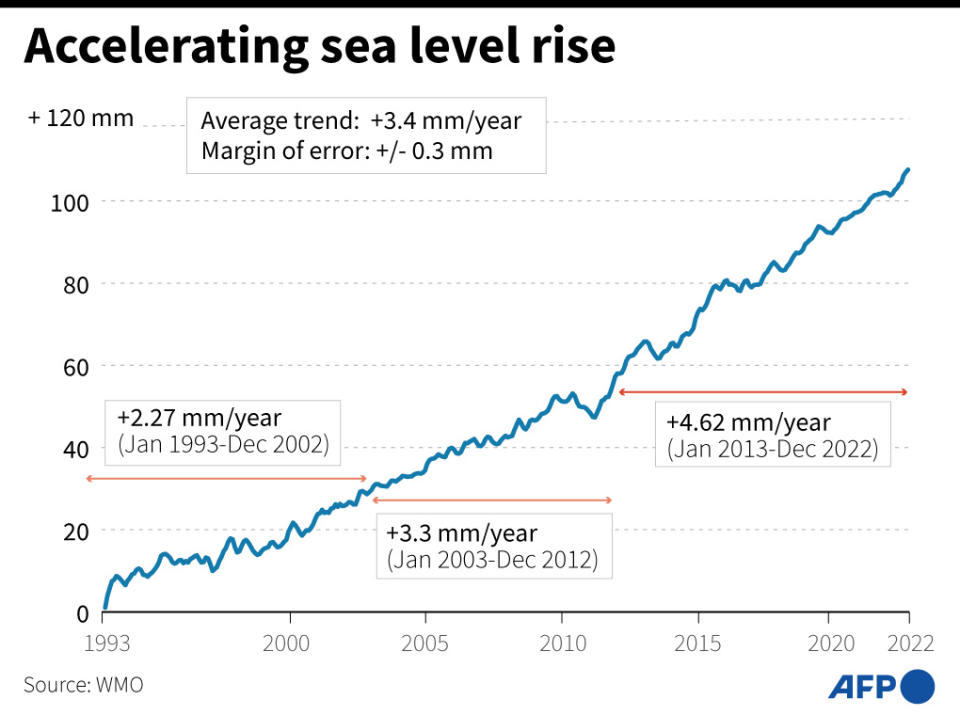Morocco study misused to discredit sea-level rise
A prominent climate skeptic claims the discovery of ancient footprints in Morocco disproves the rise of sea levels caused by human activity. But the research is unrelated to climate change, a co-author told AFP -- and global data indicate average sea levels are increasing at an unprecedented rate.
"Climate narrative stepped on: Newly discovered footprints indicate sea level was 20-30 meters higher than today 90,000 years ago when CO2 was at pre-industrial levels of 275 ppm (parts per million)," says Steve Milloy, a former Fox News contributor who has previously spread misinformation about global warming, in a May 6, 2024 post on X.

Milloy's post, which references the ratio of carbon dioxide in the atmosphere, points to a January study (archived here) analyzing recently discovered footprints attributed to anatomically modern homo sapiens on the coast of North Africa.
A co-author told AFP the paper does not disprove the science of sea-level rise.
"We did not say that in our work at all, and we are not against the scientific consensus about climate change," said Juan Morales, a professor at the University of Huelva in Spain (archived here), on May 22.
While oceans rise and fall (archived here) over time, human-produced greenhouse gases are warming the planet -- thereby melting glaciers and ice sheets and raising sea levels (archived here).
'Raised beaches'
The fact that ancient human footprints were found on a beach in Morocco would seem to indicate sea levels 95,000 years ago were "more or less the same as the present," Morales said.
However, he said the shoreline's apparent consistency is likely due to a phenomenon known as isostatic rebound, in which land rises and offsets the weight lost by ice sheets (archived here and here).

Iris Möller, a coastal geomorphologist and professor at Trinity College in Dublin, Ireland (archived here), also pointed to coastal uplift as an explanation.
"The African plate colliding with the Eurasian plate has been causing such uplift of beaches, as well as tsunami deposits mistaken for beaches at similarly high elevations, resulting in so-called 'raised beaches' in parts of the Mediterranean," she said May 9.
Moeller added that "even taking into account uncertainty in evidence, we can be certain that -- at least in terms of global average sea level -- sea level was most definitely lower than today 90,000 years ago. Temperatures were lower and more ice was held on land with less in the oceans."
Accelerating pace
The UN Intergovernmental Panel on Climate Change (IPCC) said in a 2021 report (archived here) that the average rate of sea-level rise increased from 1.3 millimeters per year between 1901-1971 to 1.9 mm per year between 1971-2006.
Between 2006 and 2018, the rate shot up to 3.7 mm per year.
"Global mean sea level has risen faster since 1900 than over any preceding century in at least the last 3,000 years," the report says, adding that human-caused emissions are "extremely likely" the culprit.

Jayantha Obeysekera, director of the Sea Level Solutions Center at Florida International University (archived here), told AFP on May 9, 2024 that "what happened over 100,000 years ago is different" from how humans are changing the climate today.
"We are warming the planet at a rate over a short period compared to the natural phenomena that happened over geological time frames," he said. "What matters to us is how sea level will rise over the next century."
Essam Heggy, a University of Southern California research scientist (archived here), agreed.
"There is a major difference between sea levels changing a couple of meters over thousands or millions of years and observing this change over the course of a hundred years as observed due to global warming," Heggy told AFP on May 14.
AFP has previously debunked other claims that the location of landmarks disproves the science of global sea-level rise.

